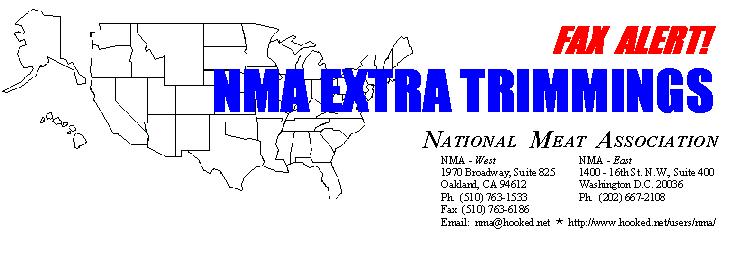

December 28, 1998
To: NMA General Members
Fr: NMA Regulatory Department, Ken Mastracchio & Teresa Frey
Re: Listeria monocytogenes
A massive recall of hot dogs and packaged meats this week was attributed to illness caused by Listeria monocytogenes. The company involved estimated the cost of the recall to be $50 million to $70 million.
Listeria monocytogenes is a gram-positive, non-sporeforming, facultative, motile, rod-shaped bacteria. It can grow at temperatures between 32� to 113�F (0� to 45� C) and survives freezing. In addition, it grows best at pH 5.0 to 9.6, at water activity (Aw) > 0.93, and has a salt tolerance of at least 5-10% or higher. It survives a pH 4.5 for 3 to 4 days. Proper heat treatment (155-160�F) will kill the pathogen; however unsanitary conditions that cause the recontamination of Ready to Eat (RTE) products can cause severe illness and death.
This bacteria, found in humans, animals, soil, milk, raw vegetables, and in cheeses made from unpasteurized milk, is ubiquitous and can survive for years in soil, plants, and water. It has been associated with such foods as raw milk, soft-ripened cheeses, ice cream, raw vegetables, and RTE meat and poultry products, both heat treated and fermented.
No known dose-load has been established and a small number of bacteria will cause illness in children. Illness begins with mild "flu-like" symptoms, which include fever, chills, headache, backache, and sometimes abdominal pain and diarrhea. Following this stage, virulent forms may multiply in the intestinal tract, be absorbed into the blood stream, and transported to other vital organs. Pregnant women may experience abortions and still births. The immuno-compromised, the elderly and newly borne infants may all die as a result of complications.
Prevention at the Plant: Manufacturers of packaged RTE products such as luncheon meats or any other packaged fully cooked products should develop and maintain Clean Room Standard Operating Procedures (SOPs) to eliminate cross contamination between RTE products and raw meat materials. The Clean Room SOPs should include; positive air movement in exposed product packaging rooms (clean rooms), restricting access to specific line personnel only, sanitizing dips for hands and foot wear, and the donning of sanitized clothing including full head covers and surgical gloves and masks. In addition, equipment cleaning and sanitizing procedures should comprehensively address both product and non-product surfaces such as the underside of product handling equipment (slicers, scales, work tables, and packaging equipment), electrical outlets and conduits, compressed air lines and filters, and equipment operating controls. Cleaning emphasis should be placed on drains, standing water, refrigeration units and all other areas that stay wet. All personnel involved in the maintenance and service of clean room equipment and facilities should meet the sanitary practices utilized by clean room operating personnel. This should also include the sanitizing of any hand tools or equipment introduced into the clean room environment.
A good preventive program incorporates microbial monitoring of the environment at an initial frequency of at least 20 samples per week. Microbial swabs should specifically target equipment contact surfaces using a sponge technique swabbing an area as large as possible for each sample. Consistently achieving negative test results may support reducing the sampling frequency to about 10 samples per week.
Decontamination Procedures: Should environmental samples indicate a presumptive for Listeria species, it is necessary to begin immediately a decontamination program that incorporates Ceiling-to-Floor strip cleaning and sanitizing. The program should begin with a dismantling of equipment in order to expose unsealed areas and removal of insulation from pipes and conduits including plastic electrical ties and duct tape. Next, thoroughly wash and clean all equipment and environmental surfaces to remove any bio-film. Then, apply a peroxide solution to all surfaces including the ceiling, walls, floors, and the product and non-product surfaces of disassembled equipment. This application should then be followed by a fogging of the room with a 1000 PPM quaternary ammonia compound to insure that all crevices and micro cracks are coated with the fine droplets. It is strongly recommended that safety precautions to protect workers be strictly adhered to when applying the quaternary ammonia compound at this strength. After 30 minutes, rinse the equipment contact surfaces, only, in preparation for use. It is important that the environment remain treated with the quaternary compound to prevent bacteria growth. Fogging should be repeated until environmental micro samples indicate that equipment surfaces are no longer contaminated with Listeria.
This Resource was prepared by the National Meat Association with the help of Dr. Steve Goodfellow and Ken Kenyon M.S., of Deibel Laboratories. Dr. Goodfellow and Mr. Kenyon may be contacted for more information by telephone at (352) 331-3313 or by fax at (352) 332-2050.